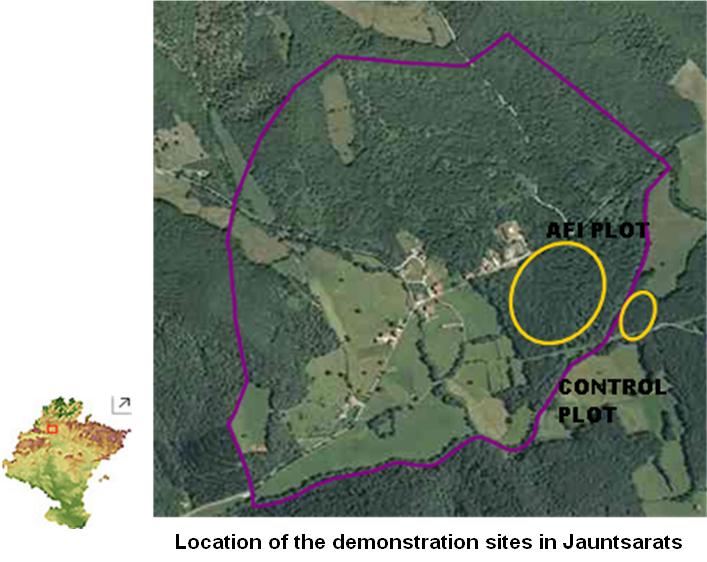DS13
Site code DS13
Location Basaburúa
Region Navarra
Country Spain
Local name Jauntsarats
Partner GAN
Site characteristics
Orientation: FLAT, Slope:3.5°, Soil :FLUVISOLS, Bedrock : siltstone
PH :6.0,
Hydrology
Drainage basin: Areta river, which belongs to Aragon river drainage basin (Mediterranean watershed)
Short History of the site
 copyrigth IEFC network
copyrigth IEFC networkThe global objective is to develop a new silviculture to slow the impacts of climatic change compatible with the production of quality wood of oak and with sustainable cost. The main objective of these demonstration trials is to study if uneven-aged forests (new silviculture) are more resistant to multiple climate change risk (strong winds, new pest and pathogens and less availability of water) than even-aged forest.This demonstration site is located in Jauntsarats, in the Northwest of Navarra. The forest is part of two M.U.P (Montes de Utilidad Pública = Public Use Forest) of Navarra. Therefore, the managing of them corresponds to Government of Navarra. Jauntsarats forest belongs to Southern humid valleys of Navarra, with hard winters and hot summers. The average annual precipitation is 1273 mm (from 1999 to 2007). Orography is not very steep, with slopes no more than 30%, and flat terrain next to Basaburua river. Soils are deep and not very rocky with predominance of marl and limestone and fine silty texture. Waterlogging problems can appear. The main especies are Quercus robur L. (38,15 ha), Fagus sylvatica (19,87 ha) and Quercus pyrenaica (11,82 ha), with Rubus sp. and Ilex sp. in the scrubland. The first Technical Management Plan for this forest was approved in 2009, and there is not disposable information about its managing before 2002. The main specie in this demonstration site is Quercus robur L., both in the control plot as in the AFI trial. The existing forest mass is characterized by high number of young trees which belongs to lowest diameter class. Quality of trees is not very high, but enough number of young trees has potential to produce quality timber. Due to the current state of the mass the growth of Fagus sylvatica L. is much favoured than oak growth, but this is supposed to change with the new sylvicultural treatment. Through this demonstration site a change in the sylviculture will be studied, from a regular high forest system, to an individualized tree sylviculture for the Quercus robur L. specie. These changes are being made in a plot part of the AFI (Association Futaie Irrégulière) plots network, where the objective is to use the PROSILVA management resulting in an irregular stand. In addition to that AFI plot, a control plot is being installed in a part of Jauntsarats forest where no actuation is planned for at least the next ten years, so the forest will not change in a short term. The main climate change risks for forest are: strong winds, new pest and pathogens and less availability of water. The hypothesis is that uneven-aged forests should be more resistant and resilient to those risks because: Their relation between height and diameter used to be lower in this kind of forest structure and it supposes bigger resistance to strong winds. An uneven-aged forest, with different ages and species within it, is more resistant to pest and pathogens outbreaks. These forests have a better use of ground water. In the AFI plot located in Jauntsarats the aim is to carry out the transition from a regular stand to an irregular stand where different species and diameters are mixed, maintaining pedunculate oak dominance and producing high quality trees.
